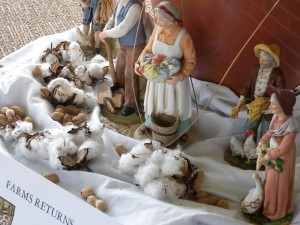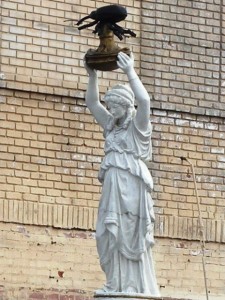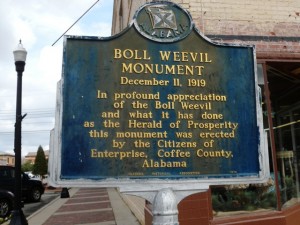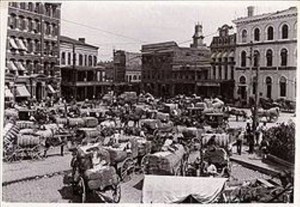» posted on Tuesday, January 15th, 2013 by Linda Lou Burton
In The Land Of Cotton
 Linda Burton posting from Montgomery, Alabama – It started as I was leaving Florida. Farmland, I mean. Just north of Gainesville I spotted cattle grazing; their green pastures half hidden behind oak trees hanging thick with moss; the soft morning fog creating pastoral scenes worthy of an art collector’s wall. You might think of Florida as the citrus state, but what I saw coming north on I-75 was cattle, and billboard ads for western wear. I crossed the Suwanee River; notes painted on its sign set the tune off in my head. Nothing touristy here, just homefolks, working their land. I’m headed for Alabama today, and Montgomery, but there’s a stop I want to make
Linda Burton posting from Montgomery, Alabama – It started as I was leaving Florida. Farmland, I mean. Just north of Gainesville I spotted cattle grazing; their green pastures half hidden behind oak trees hanging thick with moss; the soft morning fog creating pastoral scenes worthy of an art collector’s wall. You might think of Florida as the citrus state, but what I saw coming north on I-75 was cattle, and billboard ads for western wear. I crossed the Suwanee River; notes painted on its sign set the tune off in my head. Nothing touristy here, just homefolks, working their land. I’m headed for Alabama today, and Montgomery, but there’s a stop I want to make  along the way. It has to do with farming, and with change. West on I-10, traffic thins and pine trees thicken; then I turn north again. Off the freeway driving slows; there’s farmland everywhere; I find myself on Cotton Street. And yes, a cotton field is to my left. The stop I want to make? The Boll Weevil Monument in Enterprise, Alabama, the only monument to an agricultural pest anywhere in the world.
along the way. It has to do with farming, and with change. West on I-10, traffic thins and pine trees thicken; then I turn north again. Off the freeway driving slows; there’s farmland everywhere; I find myself on Cotton Street. And yes, a cotton field is to my left. The stop I want to make? The Boll Weevil Monument in Enterprise, Alabama, the only monument to an agricultural pest anywhere in the world.
 The boll weevil (Anthonomus grandis) first appeared in Alabama in 1915. Now, the boll weevil likes to eat cotton, and there was plenty of it in Alabama. Go all the way back to the 1830’s, when cotton plantations were Alabama’s greatest source of wealth. Before the Civil War, these plantations were worked by slaves; after the war, and emancipation, freed slaves and their descendants continued to work the cotton fields as laborers and sharecroppers. And farmers continued to prosper growing cotton. Until the boll weevil came along.
The boll weevil (Anthonomus grandis) first appeared in Alabama in 1915. Now, the boll weevil likes to eat cotton, and there was plenty of it in Alabama. Go all the way back to the 1830’s, when cotton plantations were Alabama’s greatest source of wealth. Before the Civil War, these plantations were worked by slaves; after the war, and emancipation, freed slaves and their descendants continued to work the cotton fields as laborers and sharecroppers. And farmers continued to prosper growing cotton. Until the boll weevil came along.
 By 1918 farmers were losing whole cotton crops to the beetle. Then a fellow by the name of H M Sessions got the idea to convert the area around Enterprise to peanut farming; peanuts, you see, aren’t the least bit attractive to boll weevils. He convinced C W Baston, an indebted farmer, to back the venture. The very first crop paid off their debts and was bought by farmers seeking to change to peanut farming. The “happily ever after” ending came true; two years later Coffee County was the leading producer of peanuts in the nation. Farmers still grew cotton (and learned to manage that pesky weevil); but they learned to diversify, not only staving off disaster, but renewing the economy with a thriving new crop base. The monument to the boll weevil was dedicated in 1919 as a tribute to how something disastrous can be a catalyst for change, and how the people of Enterprise adjusted in the face of adversity. Good lesson there.
By 1918 farmers were losing whole cotton crops to the beetle. Then a fellow by the name of H M Sessions got the idea to convert the area around Enterprise to peanut farming; peanuts, you see, aren’t the least bit attractive to boll weevils. He convinced C W Baston, an indebted farmer, to back the venture. The very first crop paid off their debts and was bought by farmers seeking to change to peanut farming. The “happily ever after” ending came true; two years later Coffee County was the leading producer of peanuts in the nation. Farmers still grew cotton (and learned to manage that pesky weevil); but they learned to diversify, not only staving off disaster, but renewing the economy with a thriving new crop base. The monument to the boll weevil was dedicated in 1919 as a tribute to how something disastrous can be a catalyst for change, and how the people of Enterprise adjusted in the face of adversity. Good lesson there.
 I found the monument at the intersection of College and Main, smack in the middle of Enterprise; I parked the car to walk around it. Traffic was thick; heavy-duty trucks pulled farming equipment; smaller pickups waited impatiently for the light to change; there was work to be done. The radio station on the corner proclaimed its name in striking white on blue: WVVL 101. The building across the street sported a mural; farming, 1882. I circled the monument; a wrought-iron railing surrounded a fountain; in the center a female figure in a flowing gown stretched her arms high above her head; in her hands she held a trophy. And atop that trophy? A really big bug.
I found the monument at the intersection of College and Main, smack in the middle of Enterprise; I parked the car to walk around it. Traffic was thick; heavy-duty trucks pulled farming equipment; smaller pickups waited impatiently for the light to change; there was work to be done. The radio station on the corner proclaimed its name in striking white on blue: WVVL 101. The building across the street sported a mural; farming, 1882. I circled the monument; a wrought-iron railing surrounded a fountain; in the center a female figure in a flowing gown stretched her arms high above her head; in her hands she held a trophy. And atop that trophy? A really big bug.
 The statue came from Italy and cost about $1,800; the weevil was not part of the original design. It was thirty years later that Luther Baker made the boll weevil and mounted it on top of the trophy. That weevil has been stolen many times throughout the years; in fact, the monument has too. Each time it was found and repaired by the city. Till July 11, 1998, when vandals ripped the boll weevil out of the statue’s hands and permanently damaged the statue; this time city leaders decided it was too costly to fix. What I’m looking at today is a polymer-resin replica; the original is safely on display at the Depot Museum at 106 Railroad Street. Meanwhile, a security camera watches.
The statue came from Italy and cost about $1,800; the weevil was not part of the original design. It was thirty years later that Luther Baker made the boll weevil and mounted it on top of the trophy. That weevil has been stolen many times throughout the years; in fact, the monument has too. Each time it was found and repaired by the city. Till July 11, 1998, when vandals ripped the boll weevil out of the statue’s hands and permanently damaged the statue; this time city leaders decided it was too costly to fix. What I’m looking at today is a polymer-resin replica; the original is safely on display at the Depot Museum at 106 Railroad Street. Meanwhile, a security camera watches.
 A virtually indestructible marker on the corner sidewalk has this inscription: Boll Weevil Monument. December 11, 1919. In profound appreciation of the Boll Weevil and what it has done as the Herald of Prosperity this monument was erected by the Citizens of Enterprise, Coffee County, Alabama.
A virtually indestructible marker on the corner sidewalk has this inscription: Boll Weevil Monument. December 11, 1919. In profound appreciation of the Boll Weevil and what it has done as the Herald of Prosperity this monument was erected by the Citizens of Enterprise, Coffee County, Alabama.
The drive was pleasant on into Montgomery; farmland as far as I could see. Last season’s cotton fields lay pocked with white; winter crops of something I didn’t recognize flashed in brilliant new-growth green. And cattle grazed.
As I begin to read about Montgomery tonight, I learn that it became the capital of  Alabama in 1847, fifth in succession after Saint Stephens, Huntsville, Cahaba, and Tuscaloosa; chosen because of its proximity to the Alabama River, and its position at the heart of cotton-growing country. The photo at right shows wagonloads of cotton being brought to market in Montgomery in 1900.
Alabama in 1847, fifth in succession after Saint Stephens, Huntsville, Cahaba, and Tuscaloosa; chosen because of its proximity to the Alabama River, and its position at the heart of cotton-growing country. The photo at right shows wagonloads of cotton being brought to market in Montgomery in 1900.
Stay tuned.
